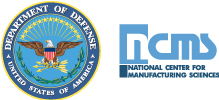069 – “Improving In-Process Control for Thermal Spray”
Author: Michael Lucis, David Ward
Company: USAF AFMC 76 PMXG
Phone: (405) 739-2948, (405) 582-1941
Email: michael.lucis@us.af.mil
In an effort to modernize the monitoring and control of thermal spray, three innovative sensors were developed and are being put into use in the 76 PMXG thermal spray area: the plume-optimization camera, the in-situ coating properties sensor, and the in-situ thickness monitor. The thermal spray process is used frequently in the overhaul and repair of engine parts to apply various coatings such as hard face coatings, thermal barrier coatings, abradable coatings, and coatings for material build up. Currently quality control for the thermal spray process is performed in post process through destructive inspection of witness coupons coated alongside the part. This post process inspection is labor intensive and high in volume, as 76 PMXG processes over 9,000 coupons per year. If the coating does not meet quality requirements, the coating must be stripped from the part and re-applied adding cost and flow days to the repair of the asset.
76 PMXG has been working with Reliacoat Technologies to develop and implement in-situ coating property sensors to characterize coating microstructure quality and thickness before the coating is applied to the asset. The plume-optimization camera (Plume Opt), also developed by Reliacoat Technologies, is used to determine optimal injection of thermal spray powder into the gun flame. This reduces powder waste and coating variability which leads to cost savings. Savings generated are substantial as thermal spray powders range from $10 to $60 per pound, PMXG powder usage totaling a cost of $1.7M per year. By implementing this in-process control, the number of recycles due to failed coating quality has been reduced. The average cost of a thermal spray recycle is $4,000 in material and labor. By demonstration of a repeatable, controlled process, intervals between destructive testing can be lengthened, reducing testing cost and reducing time components spend waiting for quality validation.

